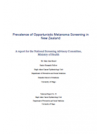This paper quantifies the prevalence of opportunistic melanoma screening in New Zealand in 2008
Purpose
This project was undertaken to describe the prevalence of, and factors associated with, opportunistic dcreening for melanoma in primary care in New Zealand.Methodology
- Participants were randomly selected from the general electoral rolls and were aged between 40 and 74 years old. The samples were weighted towards Māori and male participants. Māori were selected on the basis of a positive Māori ancestry listed on the general electoral rolls.
- Questionnaires were mailed to participants, and if no reply was received they were contacted by telephone. Trained interviewers conducted all telephone interviews using the standard questionnaire.
- As the risk of developing melanoma and the types of melanoma occurring differ by ethnic group, the 26 people with sole Asian or Pacific ethnicity were excluded from the main analysis.
- Educational attainment was categorised by highest qualification gained. Main occupations before retirement were recorded. Socioeconomic status was categorised from a high of 1 to a low of 6 according to occupation using the New Zealand Socioeconomic Index of Occupational Status.
- As DHB areas were too small for useful statistical analysis, Transitional Health Authority (THA) areas (Northern THA: Auckland and Northland; Midland THA: Waikato, Bay of Plenty, Lakes, Tairawhiti, and Taranaki; Central THA: Hawkes Bay, Manawatu, Wanganui, Wairarapa, Wellington, Porirua, Kapiti, Nelson, Marlborough, and Chatham Islands
- Participants were asked about the natural colour of their hair as a teenager, their natural eye colour and the colour of their skin in the middle of winter. From these three variables an overall phenotype was derived and then categorised into tertiles. Skin reaction to sunlight and tanning response were self-assessments of skin behaviour with no sunblock after 1 hour of sun exposure at the beginning of summer.
- Three skin examination outcome variables covering two different time periods (in 2008 or in the 5 years prior to 2008 i.e. 2003-2007) were collected. First, a complete skin examination included a total body or almost complete skin examination (excluding genitalia and head) from a general practitioner, nurse, workplace doctor or nurse, dermatologist or other specialist, mobile clinic, or MoleMap and similar clinics. Second, a complete skin examination in primary care excluded skin examinations performed by dermatologists and specialists, or their nurses, but included all others. Third, a screening skin examination in primary care only included skin examinations that were part of a general or annual check-up, a workplace skin or general check-up, a request for an examination by the patient although they had not seen anything unusual, a request for a skin examination by a doctor although he or she had not apparently seen anything unusual, or a skin check following a previous skin cancer diagnosis. All follow-up skin checks soon after a diagnosis of melanoma or other skin cancer (such as to check a skin graft site), or because of a rash or other skin disease, or skin checks for the examination of a suspicious or unusual lesion were excluded from this outcome variable.
- All statistical tests were done using Stata 10.
- All ‘don’t know’ responses and missing values were excluded from analyses unless otherwise stated. Crude, and age- and sex adjusted proportions were calculated using 5-year or 10-year age groups and the WHO standard population aged 40-74 years. Comparison of crude proportions within groups of categorical variables was carried out using Pearson's χ2 test. The 95% confidence intervals for adjusted proportions were calculated. A binomial linear regression model was fitted to examine univariate and multivariate associations of factors with skin examination outcome variables. This model generated risk ratios that were interpretable as relative risks. Tests for trend in adjusted relative risks were done across ordered categories for categorical variables. A two-sided α of 0.05 was used for all statistical tests. No adjustment was made to confidence intervals or p-values for multiple hypothesis tests. THA: all South Island except Nelson and Marlborough) were used instead. The THAs were assigned from domicile codes on the electoral rolls.

